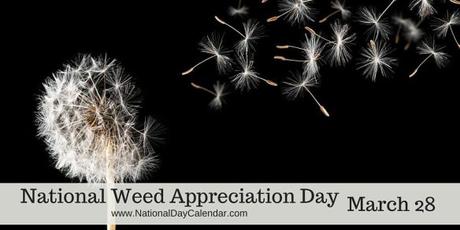GR: Today is National Weed Appreciation Day. As the benefits of weeds are the subject of my new book, I thought it appropriate to mention the day. My soon-to-be-published book describes and illustrates the edible and medicinal weeds growing at Coldwater Farm in Dewey-Humboldt, Arizona. Since all of the weeds found in Dewey-Humboldt occur elsewhere, many worldwide, the book is of value to anyone wanting to learn more about weeds.

“Did you know that some weeds are beneficial to us and our ecosystem? National Weed Appreciation Day is observed on March 28 of each year, and it is a good day to learn more about weeds and their benefits.
“Humans have used weeds for food and as herbs for much of recorded history. Some are edible and nutritious while other weeds have medicinal value.
“Do you remember as a small child the fun you had with dandelions? Well, these bright yellow flowers serve a purpose. Dandelions are a food source for insects and some birds. Humans eat young dandelion leaves and enjoy tea and wine made from the leaves and flower. The Native Americans used dandelions to treat certain ailments. Nutritionally, dandelions contain a source of vitamin A and C, calcium, iron and fiber.
“There are also other edible and medicinal weeds, some of which include: Yellow Dock/Burdock: The taproot of young burdock plants can be harvested and eaten as a root vegetable. Immature flower stalks may also be harvested in late spring before flowers appear. The flavor of the young stalk resembles that of an artichoke. It is a good source of dietary fiber and certain minerals, including calcium and potassium. It is also used as a medicinal herb.
“Lamb’s Quarter: (also known as goosefoot) The leaves of lamb’s quarter are excellent added to lettuce salads or cooked and used as a replacement for spinach. Lamb’s quarter seeds are also edible. They are a good source of protein and vitamin A.
“Amaranth: (also known as pigweed) Amaranth species are cultivated and consumed as a leaf vegetable in many parts of the world. The leaves can be cooked, and its seeds can be harvested and cooked the same as quinoa. The root of mature amaranth is a popular vegetable. It is white and usually cooked with tomatoes or tamarind gravy. It has a milky taste and is alkaline. It is high in vitamins and minerals, including vitamins A, K, B6, calcium and iron, and the seeds are a good source of protein.
“Purslane: It may be eaten as a leaf vegetable, but is considered a weed in the United States. It has a slightly sour and salty taste. The stems, leaves and flower buds are all edible. Purslane may be used fresh as a salad, stir-fried or cooked as spinach is, and because of its sticky quality, it also is suitable for soups and stews. It is an excellent source of vitamins, minerals and antioxidants and is high in omega-3 fatty acids. Purslane can be found growing in all 50 states.” Source: NATIONAL WEED APPRECIATION DAY – March 28 | National Day Calendar
Eat your lawn on National Weed Appreciation Day

